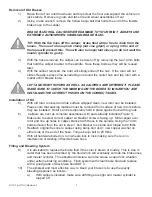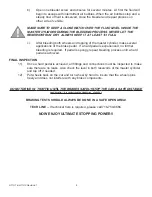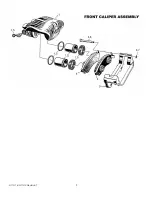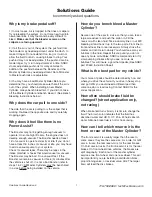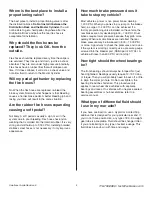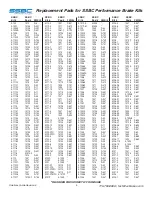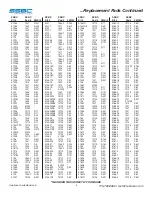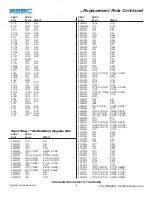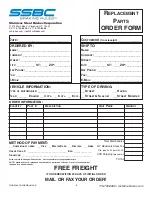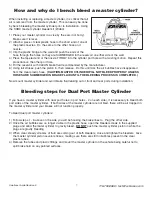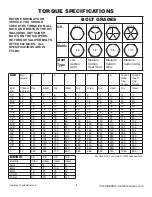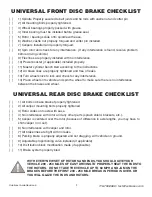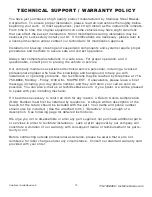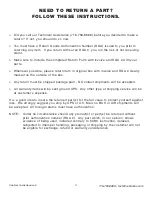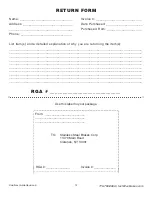
Solutions Guide Revision 5
716-759-8666 • tech@ssbrakes.com
How do you bench bleed a Master
Cylinder?
Secure one of the ears in a vise so that you can take a
large screwdriver and push the piston in. Fill the
reservoir with clean fluid. Take a dummy line or our M/C
bleeding kit and hook it up to the two ports. Front line to
front and rear line to rear reservoirs. Slowly stroke the
master and let it return slowly. You should see many air
bubbles in the fluid. Repeat this step until you do not
see any more air bubbles. SSBC recommends ten (10)
slow pumping strokes after you see no more air
bubbles. This will insure a good hard pedal. (See SSBC
part #0460 Instruction Sheet)
What is the best pad for my vehicle?
Your choice of pads should be determined by how and
where you drive the vehicle. If you drive in heavy stop
and go traffic you would need a different pad than
someone who is road racing. Contact SSBC for the
correct application.
How often should brake fluid be
changed? (street application only,
not racing)
When brake fluid turns brown, it is time to change the
fluid. The brown color indicates that the fluid has
absorbed water and dirt. D.O.T. #3 & #4 fluids absorb
water. Silicone brake fluid is not for track racing.
How can I tell which reservoir is the
front or rear of the Master Cylinder?
The front reservoir is usually larger than the rear. In
some cases, they are the same size. As a rule, for GM
cars & trucks, the rear reservoir is for the rear brakes.
On Ford cars & trucks, the front reservoir is for the rear
brakes. On front wheel drive vehicles, the brakes are
split diagonally. Each bowl of the master cylinder
services one front wheel and one rear wheel. This will
be important if you are installing a distribution block,
proportioning valve, or residual valve. Hint: The larger
bowl will feed the disc brakes.
1
Why is my brake pedal soft?
1) In most cases, Air is trapped in the lines or calipers.
Try re-bleeding the system. Do not force new fluid into
new brake lines. It may foam and be very difficult to
bleed.
Make sure that the bleeder screws on the
calipers are facing upward!
2) If all the air is out of the system, the pushrod from
the booster may need adjustment, under the dash, to
make it longer. Do not extend it too long or it will not
allow the fluid to return, causing brakes to drag. Your
pushrod may not be adjustable. If the pushrod can be
made longer, try ¼ turn adjustments at a time. SSBC
stocks adjustable pushrods for many vehicles. In
addition, the pushrod between the Booster and the
Master Cylinder may need adjustment. Not all Booster
to Master pushrods are adjustable.
3) You may have a bad Master Cylinder. Before you
determine this, you should make sure that all the air is
out of the system. When installing a new Master
Cylinder, always bench bleed first. If you did not, take
off the Master Cylinder and bench bleed it. (See Bench
Bleeding Instructions below)
Why does the car pull to one side?
The side that the car is pulling to is the caliper that is
working. Re-bleed the opposite side and try carefully
stopping again.
Why does it feel like there is no
Power Assist?
The Booster may not be getting enough vacuum to
operate. On some high lift cams, the engine does not
develop enough vacuum. The Booster needs at least
16” of vacuum to operate correctly at idle. If you do not
have at least 16 inches of vacuum at idle, you may have
to add a vacuum pump to your system.
Check for vacuum leaks. There may be leaks in the
intake manifold or hoses that would cause low vacuum.
The Booster may be bad. Do a vacuum test. If the
Booster can retain a vacuum for three (3) minutes after
the vehicle is shut off, it is not a bad Booster (refer to
steps 1 & 2). All Master Cylinders must be bench bled
in a vise before being installed on the vehicle.
Solutions Guide
to commonly asked questions.


